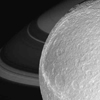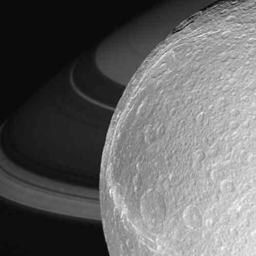
Animation
Ice Moon RendezvousZooming in closer and closer, this movie chronicles Cassini's targeted flyby of Dione, with Saturn and its lovely rings forming a dramatic backdrop.
The movie begins with Cassini during its approach about 107,000 kilometers (66,000 miles) from the icy moon. Few surface details are discernible from this distance, but the view quickly improves. The movie jumps to a point 39,000 kilometers (24,000 miles) from Dione, with Saturn's atmosphere now in the background and draped by threadlike ring shadows.
As the spacecraft gets still closer, the camera focuses on bright fractures in the west. It becomes apparent that these braided canyons slice through older craters. At the closest point in this approach sequence, Cassini is about 4,000 kilometers (2,500 miles) above Dione's surface and the image scale is 234 meters (768 feet) per pixel. For a narrow-angle camera image taken at almost the same instant see PIA07748.
A dramatic shift in perspective follows, with Cassini moving past the point of closest approach and staring at a large crater on Dione's receding limb. Steep cliffs gleam in the sunlight as the intrepid craft pulls away. About three and a half hours have elapsed since the first image in the movie was taken.
This movie was created from clear-filter images taken during the Oct. 11, 2005, flyby of Dione. All images except the departing view were obtained with the Cassini spacecraft wide-angle camera.
The Cassini-Huygens mission is a cooperative project of NASA, the European Space Agency and the Italian Space Agency. The Jet Propulsion Laboratory, a division of the California Institute of Technology in Pasadena, manages the mission for NASA's Science Mission Directorate, Washington, D.C. The Cassini orbiter and its two onboard cameras were designed, developed and assembled at JPL. The imaging operations center is based at the Space Science Institute in Boulder, Colo.
For more information about the Cassini-Huygens mission visit http://saturn.jpl.nasa.gov. The Cassini imaging team homepage is at http://ciclops.org.

 Planetary Data System
Planetary Data System













